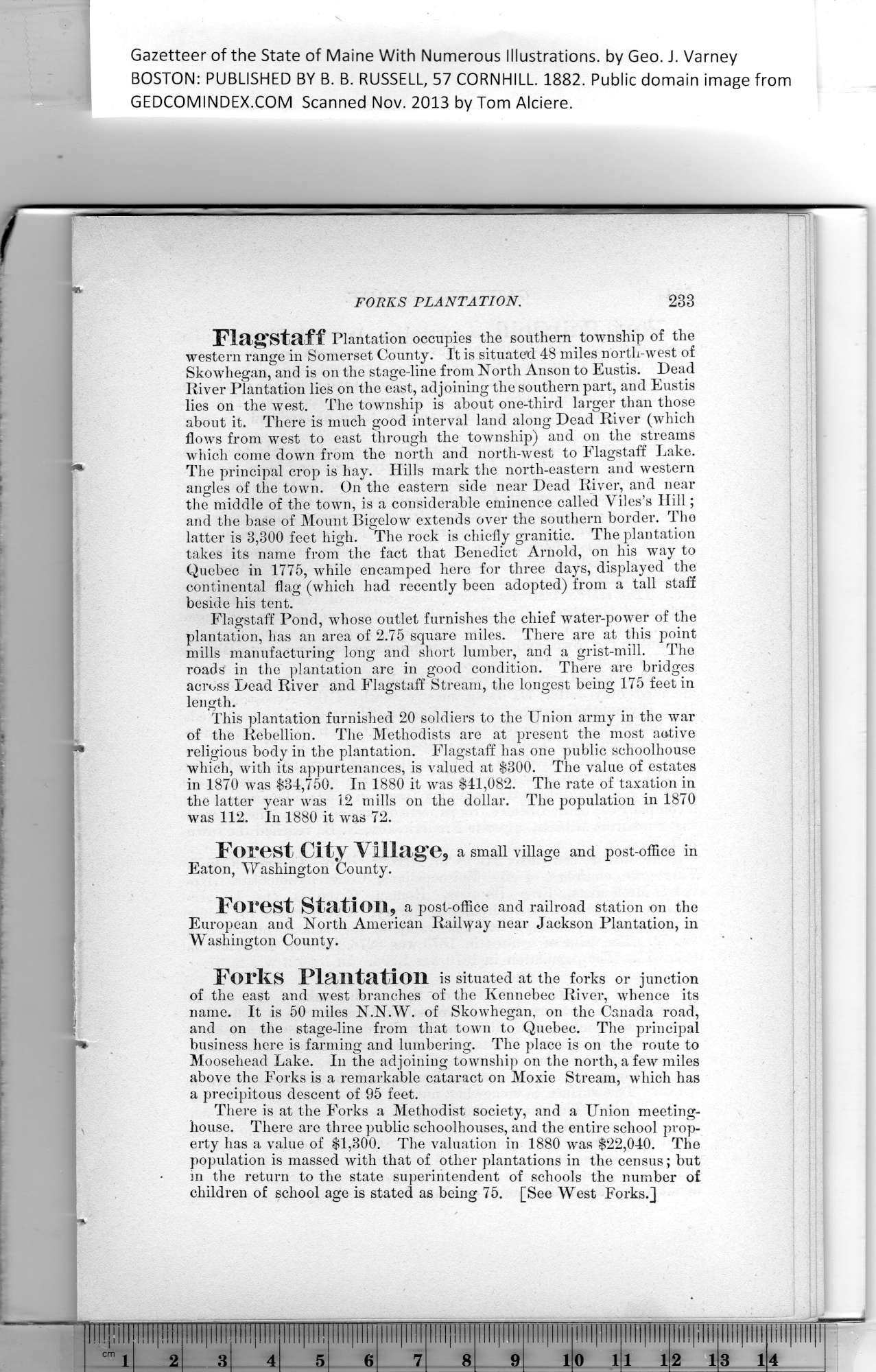|
Gazetteer of the State of Maine With Numerous Illustrations, by Geo. J. Varney
BOSTON: PUBLISHED BY B. B. RUSSELL, 57 CORNHILL. 1882. Public domain image from
FORKS PLANTATION. 233
Flagstaff Plantation occupies the southern township of the
western range in Somerset County. It is situated 48 miles north-west of
Skowhegan, and is on the stage-line from North Anson to Eustis. Dead
River Plantation lies on the east, adjoining the southern part, and Eustis
lies on the west. The township is about one-third larger than those
about it. There is much good interval land along Dead River (which
flows from wrnst to east through the township) and on the streams
which come down from the north and north-west to Flagstaff Lake.
* The principal crop is hay. Hills mark the north-eastern and western
angles of the town. On the eastern side near Dead River, and near
the middle of the town, is a considerable eminence called Viles’s Hill;
and the base of Mount Bigelow extends over the southern border. The
latter is 3,300 feet high. The rock is chiefly granitic. The plantation
takes its name from the fact that Benedict Arnold, on his way to
Quebec in 1775, while encamped here for three days, displayed the
continental flag (which had recently been adopted) from a tall staff
beside his tent.
Flagstaff Pond, whose outlet furnishes tbe chief water-power of the
plantation, has an area of 2.75 square miles. There are at this point
mills manufacturing long and short lumber, and a grist-mill. The
roads in the plantation are in good condition. There are bridges
across Dead River and Flagstaff Stream, the longest being 175 feet in
length.
This plantation furnished 20 soldiers to the Union army in the war
of tbe Rebellion. The Methodists are at present the most active
* religious body in the plantation. Flagstaff has one public schoolhouse
which, with its appurtenances, is valued at $300. The value of estates
j in 1870 was $34,750. In 1880 it was $41,082. The rate of taxation in
f the latter year was 12 mills on the dollar. The population in 1870
was 112. In 1880 it was 72.
Forest City Village, a small village and post-office in
Eaton, Washington County.
Forest Station, a post-office and railroad station on the
European and North American Railway near Jackson Plantation, in
Washington County.
Forks Plantation is situated at the forks or junction
of the east and west branches of the Kennebec River, whence its
; name. It is 50 miles N.N.W. of Skowhegan, on the Canada road,
: and on the stage-line from that town to Quebec. The principal
% business here is farming and lumbering. The place is on the route to
Moosehead Lake. In the adjoining township on the north, a few miles
above the Forks is a remarkable cataract on Moxie Stream, which has
a precipitous descent of 95 feet.
There is at the Forks a Methodist society, and a Union meeting-
house. There are three public schoolhouses, and the entire school prop-
erty has a value of $1,300. Tbe valuation in 1880 was $22,040. The
population is massed with that of other plantations in the census; but
; • in the return to the state superintendent of schools the number of
j children of school age is stated as being 75. [See West Forks.j
PREVIOUS PAGE ... NEXT PAGE
This page was written in HTML using a program written in Python 3.2
| 